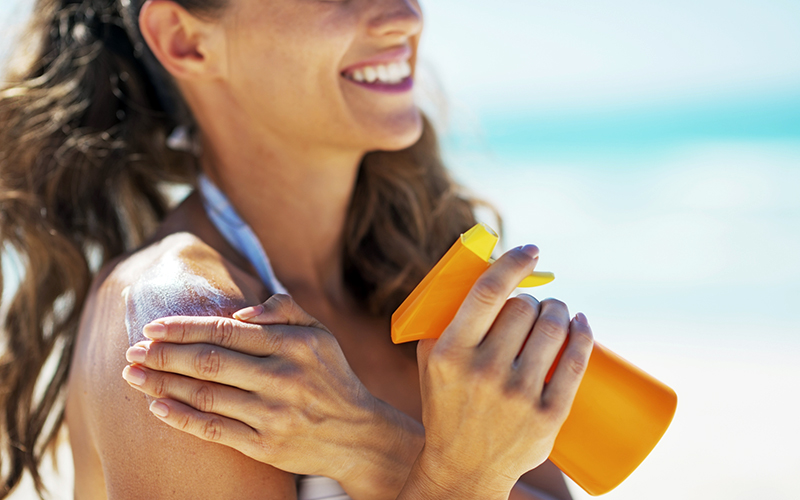
by guest blogger Toni Becker, member of the Rodale’s editorial team
Sunshine is great, but the sun’s rays? Not so much. Both UVA and UVB rays pose serious health risks, such as premature aging, eye damage, and skin cancers.
While the skincare industry has made many advances in creating sun-protective products over the years, just how safe are the products currently on the shelves, really? According to the Environmental Working Group (EWG), 80 percent of the 1,700 products they examined for their 2015 sunscreen guide offer inferior sun protection or contain worrisome ingredients like oxybenzone and vitamin A.
There are two main types of sunscreen, those made with chemical filters and those made with mineral filters. Zinc oxide, which provides a mineral filter, is EWG’s first choice for sun protection. But there are other important considerations regarding these products.
Before you liberally apply that sunscreen, read up on these safety tips:
#1: Avoid sunscreens with oxybenzone. This hormone-disrupting chemical is easily absorbed into the bloodstream. In a study done by the Centers for Disease Control and Prevention, oxybenzone was detectable in 97 percent of the population. This type of endocrine disruptor can cause issues that range from thyroid problems to cancer. Oxybenzone has also been linked to skin allergies.
#2: Skip the vitamin A. Also known as retinol, vitamin A is regularly used as an additive in sunscreens. But some government studies have suggested that when the sun hits the skin, the vitamin could trigger the development of skin tumors and lesions. EWG recommends that consumers avoid sunscreens, lip products, and skin lotions that contain vitamin A.
#3: Avoid chemical aerosols. Spraying on your sunscreen protection is not a good idea because the chemicals make their way into your body via the nose-to-lung route.
#4: Skip the fragrance, too. Research suggests that some synthetic fragrance chemicals, which are listed simply as “fragrance” or “parfum” on the ingredients label, can lead to allergies and asthma. The term fragrance is also a catchall that can indicate any of thousands of different chemicals, including some that are carcinogens and reproductive toxins.
#5: Be wary of nanoparticles. While EWG rates sunscreens containing mineral filters like zinc oxide or titanium dioxide as safer than sunscreens made with chemical filters, when the minerals are made into tiny particles, those nanoparticles can be a concern. As the particles in sunscreen get smaller, the SPF is increased, but protection against UVA rays worsens. Data also suggest these tiny particles can enter cells and produce toxic effects when they accumulate in the human body. Also, titanium dioxide nanoparticles in particular have made their way into in water runoff and are destroying beneficial microorganisms that keep our watersheds healthy. Particles of zinc oxide like those in this Suntegrity Face Sunscreen + Primer are larger, so are safer even while offering broad-spectrum protection.
#6: Don’t be fooled by high SPFs. The Food and Drug Administration has proposed regulations to prohibit sunscreen companies from labeling products as having an SPF higher than 50 because it’s misleading. A bottle with a high SPF might give people a false sense of security that leads them to stay in the sun longer than they should or to not apply it correctly or reapply it often enough. There’s also no clear proof that these higher SPFs really protect any better than a sunscreen rated at 50.
#7: Don’t just rely on just sunscreen. There are steps you can take other than slathering on lotion to protect your skin from sun exposure. Be sun smart: Avoid being outside during the sun’s strongest times, between 10 a.m. and 4 p.m. American Academy of Dermatology (AAD) reminds us that if our shadows are shorter than we are, we should find some shade. And be extra defensive when you are near water, snow, or sand…the reflection can boost your risk of a dangerous burn. Also, consider wearing UPF-30 clothing, beach cover-ups, and a broad-rimmed hat.
 Toni Becker is a part-time content creator at Rodale’s. She is also the personal chef, event planner, chauffeur, and best of all playmate to her young daughter. Her family of three lives in the woods where she finds time to write, cook anything she can from scratch, garden, and build her case of why she needs goats.
Toni Becker is a part-time content creator at Rodale’s. She is also the personal chef, event planner, chauffeur, and best of all playmate to her young daughter. Her family of three lives in the woods where she finds time to write, cook anything she can from scratch, garden, and build her case of why she needs goats.
Some of the content in this post was taken from an article that originally ran on Rodale Wellness.




No comments yet.